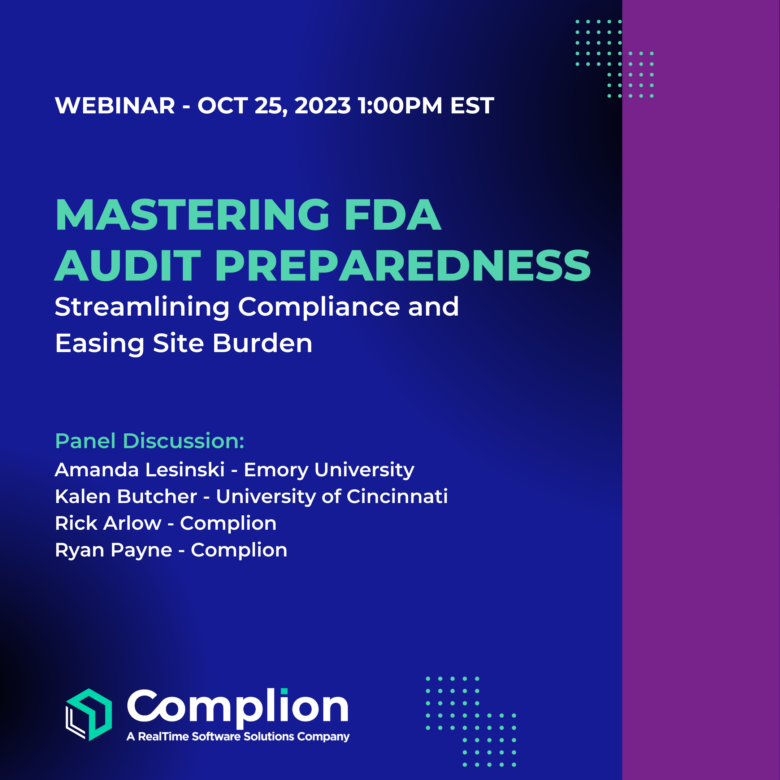Breathe easy knowing your site is compliant. Complion’s team has developed expertise in 21 CFR Part 11 regulations. Not only is our platform Part 11 compliant, we will partner with you to do everything required for compliance, including validation, training and process development.
21 CFR Part 11 Compliance for Clinical Research Sites
Clinical research sites that use electronic records and signatures must comply with Rule 21 CFR Part 11 — or risk an FDA audit.
Understanding and following the detailed regulations around 21 CFR Part 11 requires a significant amount of time, resources, and knowledge. We’re here to pass along to you as much of this information as possible so you can navigate with ease everything required for compliance — including validation, training and process development.
To start — why do we have to follow Rule 21 CFR Part 11 in the first place?
The Rise of Electronic Records & Signatures
U.S. Federal Regulation Title 21, Chapter 1, Part 11 was originally established in March 1997. It outlines the detailed regulations for, “. . . electronic records, electronic signatures, and handwritten signatures executed to electronic records to be trustworthy, reliable, and generally equivalent to paper records and handwritten signatures executed on paper.”
In short, 21 CFR Part 11 exists thanks to the advent of electronic records and signatures.
Research coordinators are responsible for a wide range of documents, including forms, signatures, monitor visits, regulatory paperwork and more. Traditionally, managing all this paperwork was a time-consuming, costly process. So, professionals turned to electronic regulatory (eRegulatory) binders to keep track of it all. This reduced many of the burdens paper presented and made it easier to move through the lifecycle of a clinical study.
Regulatory authorities recognized the need to support and formally reflect these processes in their guidance. Thus, 21 CFR Part 11 was born.
Over 20 years later after its initial issuance, the regulation is now more relevant than ever. Systems have matured. Automation is a reality. More professionals use electronic records and signatures. Digital document management in life sciences has become the new standard. Which means organizations need to follow 21 CFR Part 11.
What is 21 CFR Part 11?
The rules of 21 CFR Part 11 apply to organizations in pharma, biotech, biologics development, medical device companies and other FDA-regulated industries.
The regulation is structured into three major sections:
- General provisions — this section discusses the overarching scope of the regulations, including when and how it should be implemented.
- Electronic records — this section sets forth the requirements for administering closed and open electronic record keeping systems and discusses how signatures should appear and link back to records. A closed system is an environment in which system access is controlled by the individuals who are responsible for the content of the electronic records that are in the system. An open system is an environment in which system access is not controlled by individuals who are responsible for the content of the electronic records that are in the system.
- Electronic signatures — a three-part section that covers the general requirements for electronic signatures, electronic signature components and controls, and controls for ID codes and passwords.
Why Does 21 CFR Part 11 Exist?
The regulation applies to all FDA program areas and was intended to permit the widest possible use of electronic technology while remaining compatible with the FDA’s responsibility to protect the public health. It addresses the costs of a paper-based system by opening the doors for firms to shift to electronic systems.
But data integrity is a vital component of ensuring the safety of medical products. Part 11 is the FDA’s way of allowing (and encouraging) the use of electronic records as much as possible but, at the same time, safeguarding the validity of electronic signatures and integrity of systems.
Specifically, Part 11 guides organizations so they can:
- Understand the right way to use software systems;
- Keep data secure;
- Trace data changes;
- Ensure approval of signatures; and
- Prevent (or detect) falsified records.
The Risk of Non-Compliance
Going digital in a highly regulated industry means the bar for compliance is set very high. If you’re found to be non-compliant during an inspection, you could be hit with an FDA Form 483 (a document that communicates concerns discovered during an inspection), a warning letter, an injunction (that may include a market recall on your products), or a consent decree. These FDA actions can result in costly penalties — directly or indirectly.
Because of the severe consequences of noncompliance, some sites are wary about going digital. But the truth is, a bad paper process can be just as non-compliant. Part 11 is designed to make it simpler for sites to get work done digitally without compromising data. Besides, staying compliant is actually fairly straightforward.
In part 2 of our series, we’ll take a look at how it’s done. Check out: 21 CFR Part 11 – Compliance.


